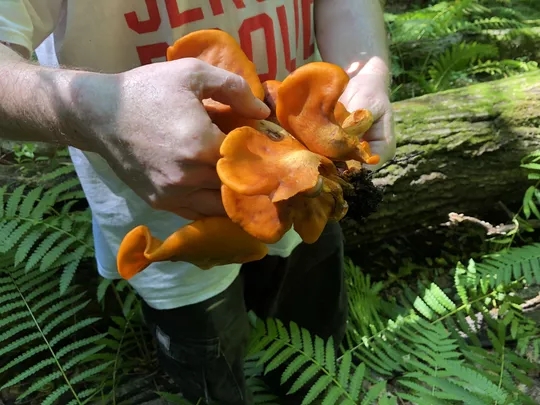
t was an odd scene for a Sunday morning: kids and adults scattered through the woods, some with wicker baskets hanging from their arms, some on their hands and knees peering at tree stumps, others stabbing at the dirt with knives — all searching the forest floor for mushrooms.
Even as they walked from the parking lot to the start of the trail at the New Weis Center in Ringwood, these mushroom lovers swapped fungi tales. “Yesterday I collected about 6 pounds of oysters and penny buns, and I just found two chanterelles in the parking lot,” said Thomas Marino of Edison.
Marino was among more than 50 people gathered for a mushroom walk — or foray — sponsored by the New Jersey Mycological Association.
The group spent two hours stepping over moss-covered rocks as they followed a trail that meandered along the Blue Mine Brook, which gurgled and bubbled through the non-profit New Weis Center’s 150 wooded acres.
Then the group gathered back near the parking lot, spread their fungi finds on wooden picnic tables, pulled out reference guides and checked mushroom websites on iPads to identify their collective treasure.
Some species are so similar that mycologists can tell them apart only by using a microscope to determine cell structure or observing how spores react to certain chemicals.
Marino said his interest in mushrooms began about six years ago when, walking in the woods, he saw “a monster-sized” chicken of the woods. “It blew my mind how bright it was — all orange and white and yellow,” Marino said. “Since then I’ve been obsessed.”
Mike Volpe of Pompton Lakes said he has been interested in mushrooms for decades because of his job as a chef. He joined the mycological association about six years ago. “I’ve learned a lot,” he said. “What’s great is as the seasons change you get all different types of mushrooms,” he said.
Like many of those who showed up, Mike and Mary Szumski of Clifton were armed with a wicker basket to carry the mushrooms they collected. Mike Szumski said he grew interested in fungi about eight years ago when walking with an uncle in Vermont. “He suddenly pointed at a chanterelle and said, ‘Hey, that’s food!’ I got hooked and started reading up on fungi. They’re hugely important to the ecosystem. Plus they’re a great excuse to go out in the woods.”
He added: "Since it’s been so hot and wet lately, it’s going to be a great day to find mushrooms.”
Nina Burghardt of Hopewell, the association’s foray chairwoman, said “mushrooms have a very complicated life cycle. Some live on the roots of trees, some put out fruiting bodies. They retain moisture, which helps the trees.
“They send out enzymes and chemicals into the soil, which break down nutrients, but they’re messy eaters, and what they don’t need the trees will use,” she said.
As Burghardt walked, her eyes scanned the rocks and tree roots for fungi. She stopped, stooped, pulled a small mushroom from the earth and stuck it up to her nose. “It’s stinks,” she said. “This is a russula. It might make you sick, but it won’t kill you.”
Calvin Lim of Elizabeth found a small section of rotted branch with dozens of mushrooms growing along it. He put that in his bag, along with several other fungi specimens he collected.
“I love mushrooms,” Lim said. “It’s my favorite food. If I had to become a vegetarian, I’d just eat mushrooms.”
Randy Hemminghaus of Jersey City, another association member leading the foray, cautioned against eating mushrooms found in the wild without properly identifying them. Some edible mushrooms have toxic lookalikes. “I’ve gotten sick from eating some, and you do need to be careful,” he said. “As the saying goes, ‘Every mushroom is edible at least once.’ ”
One of the most deadly mushrooms that grow in New Jersey is amanita virosa, aptly nicknamed the destroying angel.
Hemminghaus said the association keeps a database of the various mushroom species its members collect on such outings, which helps them spot changes over time. There are some species they no longer find in New Jersey, while other species have started to show up, perhaps a function of climate change, he said.
At one point, Hemminghaus came across a bunch of bright orange mushrooms growing on a decaying tree. It was Jack O’Lantern, a mushroom with two distinctions: Though it can make you sick, people sometimes confuse it with edible chanterelles, and it glows in the dark.
As the walk progressed, the wicker baskets filled with all kinds of colorful mushrooms, from purple tooth and coral mushrooms to waxy caps, cinnabar-red chanterelles and chicken of the woods. The last variety — with alternating circular lines of yellow and orange — were growing off the side of a dead tree, some as big as dinner plates.
When Mike Volpe heard about the find, he sounded wistful. “That’s a good score,” the chef said. “They taste great.”
For more information about programs and events at The New Weis Center for Education, Arts & Recreation, visit the web site.
























